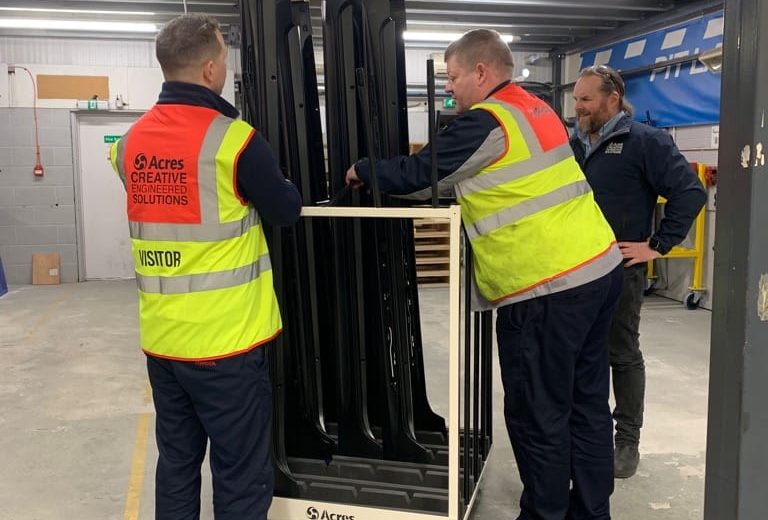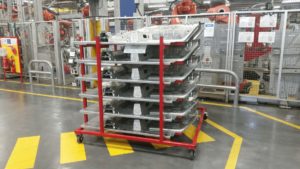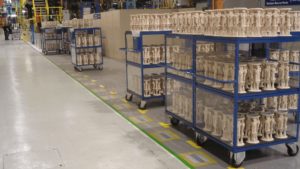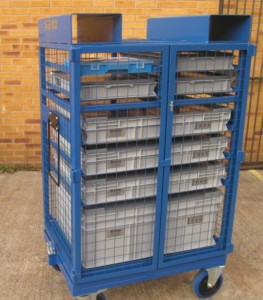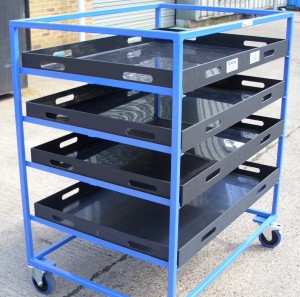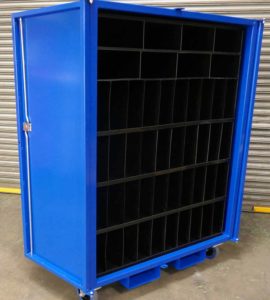How many trolleys do I need in my logistics loop?
Whether it is an internal or external logistics loop, it’s important to understand how many trolleys you will need…
At Acres Engineering we design and manufacture custom kitting media and trolleys for internal processes. The trolleys we manufacture hold and transport components as they move between processes, and potentially to external suppliers.
It is important to understand how many trolleys will be required in a loop. Stopping production due to a lack of trolleys is not a decision any process owner wants to make, just because they don’t have anything to put components on. In this situation, operators may use their initiative and find a temporary solution, but that temporary solution may present risks to the quality of your components or efficiency of your manufacturing process. Margins at exceptionally tight in manufacturing and the last thing any manufacturer wishes to do is make scrap!
Calculating the precise number of trolleys needed is not just about logistical efficiency but also about strategic business management. It ensures that all aspects of the supply chain are aligned, which in turn supports overall business objectives.
What are the key benefits of calculating how many trolleys you require in your logistics loop, and how do those benefits contribute to the efficiency, cost-effectiveness, and reliability of your supply chain operations?
- Optimising Resource Allocation – Knowing the exact number of stillages needed helps in efficiently allocating resources. Overestimating the number can lead to unnecessary capital expenditure and storage space, while underestimating can cause delays and operational disruptions.
- Cost Efficiency – Accurate calculations help minimise costs by reducing the need for purchasing or renting excess trolleys. This also reduces the overhead costs associated with storing unused equipment.
- Streamlining Operations – Having the right number of trolleys ensures that goods are moved through the supply chain smoothly without delays. This optimisation is critical in industries where time-sensitive delivery is crucial, such as fresh food, pharmaceuticals, or just-in-time manufacturing supplies.
- Reducing Downtime – By accurately planning for the number of trolleys needed, including buffer stocks for maintenance or unexpected demands, you can reduce the risk of downtime in your operations. This planning helps in maintaining continuous flow and productivity.
- Improving Inventory Management – Proper calculation aids in better inventory management by aligning the physical movement of goods with inventory levels. This helps in avoiding overstocking or running out of stock.
- Enhancing Customer Satisfaction – Reliable and efficient logistics operations, facilitated by having the right number of trolleys, lead to on-time deliveries and higher service levels, enhancing customer satisfaction and retention.
- Environmental Impact – Efficient use of stillages also means optimising the logistics operations in terms of vehicle load and trips, which can reduce the carbon footprint associated with transportation activities.
- Flexibility and Scalability – Knowing your trolley needs allows for better planning and scalability of operations. As demand grows or decreases, you can adjust your resources accordingly without significant disruptions.
Calculating the number of trolleys required in a logistics loop involves understanding your specific requirements and logistics processes. Here are some steps to help you estimate the number of trolleys needed:
- Determine the Volume or Number of Items: Start by determining the total volume or number of items that need to be transported within your logistics loop during a given period (e.g., daily, weekly).
- Trolley Capacity: Know the capacity of one trolley. This includes the maximum weight it can carry and the volume or number of items it can hold.
- Cycle Time: Understand the cycle time, which is the time it takes for a trolley to complete one loop of its journey, from being loaded, transported, unloaded, and returned.
- Buffer Stock: Consider the need for buffer stock of stillages to account for any delays, maintenance, or unexpected increases in volume. This ensures that you have enough trolleys available at all times to keep your operations running smoothly.
Use the following formula to calculate the total number of trolleys needed:
For example:
Where:
Total Volume or Items is the total amount of goods to be transported.
Capacity per Stillage is how much each trolleys can hold.
Cycle Time is the total time it takes for a trolley to go through the entire logistics loop.
Time Period of Logistics Loop is the frequency at which the loop operates (e.g., daily).
Buffer is an additional percentage or number of trolleys added to the calculation to account for uncertainties.
This is a basic model and might need adjustments based on more complex factors specific to your logistics operations, such as varied item sizes, different transport times, or irregular schedules. Adjust the parameters as needed to match your actual conditions.
If you are thinking of setting up a new logistics loop get in touch below and talk to us about your requirements?
If you are going to be transporting or storing painted parts, take a look at our information guide to ensure they do not get damaged.
Acres have a range of standard products but also support clients with custom machinery and medium-high volume products such as trolleys, stillages etc.
We have manufactured lots of different tables / workstations / workbenches for various industries.
We also manufacture access platforms, jigs and fixtures and many other types of production support solutions / products.
Talk to us today about your requirements: [email protected] / 01332695240 / Contact Us Form
Click on the icon to check out our social media! Please follow, like and share!
Want to know more about Acres Engineering?
We are based in the UK from our Headquarters in Derbyshire, England and have a European office in Malaga, Spain within the EU.
Find out more about where we have been and what we have been up to by checking out our latest blog posts.
Take a look at how we support of the Armed Forces, STEM/Schools and Charities.
As a world leader in our field, we offer a range of information guides sharing best practice with our clients.
We make it easy to engage with us, we are approved on: EcoVadis (external) / JOSCAR (external) / AVETTA (external) / COUPA (external) / SAP ARIBA (external) / DEEPSTREAM (external) ….you can download our BSI / Insurance certificates here.

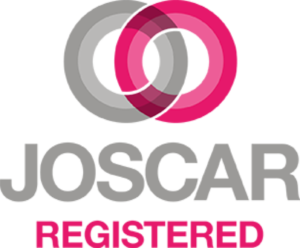


![]()
![]()
![]()
